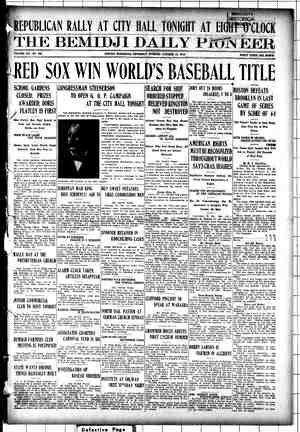The Nonpartisan Leader Newspaper, October 12, 1916, Page 7
You have reached the hourly page view limit. Unlock higher limit to our entire archive!
Subscribers enjoy higher page view limit, downloads, and exclusive features.
o o tEneBERAte=8 SRlpd sy W . + A tonnage tax on iron ore such as was once proposed would “take all the profit out of the industry” it was asserted by steel trust spokes- men.- Statements of the head of the steel cor- poration show that this assertion was ridiculous. trust pay a-larger sum to the state of Minnesota for the privilege of stripping it of its treasure, but it could pay twice or even three times the amount of state tax it now pays without making any United States steel trust it owns_ at least 770 per cent of the i 3 : . vast iren:ore deposits of north- 3 eastern . Minnesota. The Great Northern railroad: interests own 20 per eent. The independent ownership, there- fore, is almost negligible. ~ N Two factors have been responsible largely for driving the control of the N deposits into the hands of the trust. e e e First, the ‘plan of taxation in' force -+ -has prevented independent owners from } holding the ore land unless they had large capital and could mine ore in large : quantities. The ore body owners must [ M pay a tax on the value of the ore in the i ground and hence 'their tax goes on ¥ " % Whether they have money to mine or not, ? % or whether they mine or not. If they do : not mine it becomes impossible to hold the ore and it must be sold o the steel * _trust or leased to the trust on a royalty : “Second, ‘the steel trust owns the rail- s . yoads that transport the ore and in the L8 2past the rates have been kept so high : e the independent: owner to mine success- TSk fully. The' steel trust can afio_rd to pay ", 70 . bigh rates to its own railroads, because \-it i just taking the money from oné . - pocket and putting it in the other, but “the independent owmer has been frogen range. The great mines of the Minnesota iron count and loaded directly onto cars which Minnesota’s Effort to Gét Profit for the State | Fror/n a Huge Natural Resource | appreciable cut into the tremendous profits now reaped. Former Governor Johnson once said in 2 message to the legislature: ¢ “During the seven years, 1900-1906 The trust has many ways to conceal its earn- ings and to keep its taxes down. The present Minnesota system of taxation tends to force the big deposits into the hands of the trust and to prevent independent companies from operating. ry are huge open pits into which trains run by circling are hauled over the “iron range railroads” directly to the steel trust’s inclusive, the two iron range railroads (owned by the steel trust) have declared dividends aggregating $21,000,000 on a total $7,112,000 of capital stock, and had on hand on June 30, 1906, after the pay- ment of $6,453,000 of dividends during the past fiscal year, an accumulated sur- plus of $9,122,000. Then the state of Minnesota, which holds the resources and has yielded these magnificent incomes to a few private and corporate interests, is the one party that receives _only a . beggarly income.” The governor was discussing the profits from the iron range railroads only, not considering the - profits from mining the ore. On the same subject Senator Knute Nelson of Minnesota said a few years later: “We have in Minnesota the greatest " body of ore in this country. Over one- half (it is now two-thirds) of all the iron ore produced in the United States is pro- duced in' the state of Minnesota. Nearly all the ore is mined by what is known in general parlance. as. the steel trust. The trust operates under the head of the Oliver Mining company. In Michigan it is the Oliver Iron _Mining company. This company either leases or owns nearly all the mines in Minnesota, and the steel trust also owns several lines of railroads running from the mining - districts down to'the lake shore. : HIGH FREIGHT RATES FREEZE OUT INDEPENDENTS “The rate of transportation on the ora from these mines on these railroads was 80 high that it practically froze out all the independent miners; they could not compete with the steel trust because the transportation rates were so high. The . steel trust could stand that, because the _very. inf) sts that own and operate the mines under: the name’ of the Oliver . Mining ‘company also control ‘the rail . foads. So the excess'in rates they paid - from the mines to the lake shore, they " got back through the companies owned: ;. by them. AR ©. | “Proceedings were instituted beforg “{he our railroad commission in Minnesota ' are for the purpose of securing a lowering @ R S P s e s e e e PO = RT3 e UL LU SN § e e | | | | |






